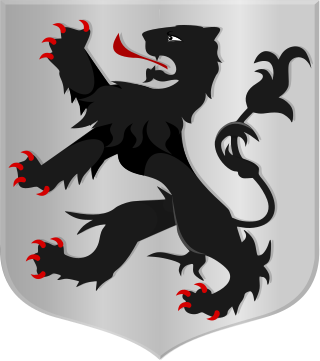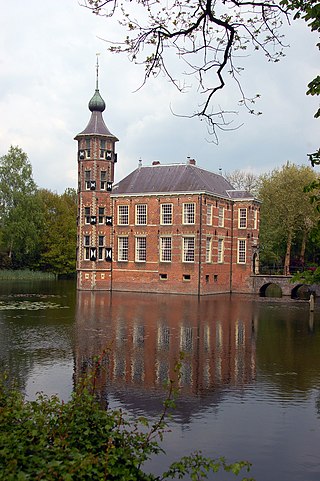History
The van Polanen family were a side branch of the van Wassenaer family which owned Kasteel Duivenvoorde since 1226. The branch took its name from Kasteel Polanen, a castle situated in Monster which was destroyed in 1351 and finally demolished in 1394.
Philips III van Duivenvoorde received the fief of Polanen in 1295. Willem van Duvenvoorde (1290-1353) purchased Oosterhout in 1324, together with vast properties around Breda and Bergen op Zoom, among them De Lek and Schoonenburg Castle (abandoned around 1450). The ruins of Kasteel Strijen, his possible residence, are still preserved in Oosterhout. Philips' son Jan I van Polanen, received the fief of Breda in 1339, together with his son John II who built a new castle there.
All of these properties were inherited by Johanna van Polanen who married Engelbert I of Nassau. Through this marriage the House of Nassau first gained territories in the Netherlands. Much later this fact, among others, led to the House of Orange-Nassau's rise to the ruling dynasty of the country.

The House of Orange-Nassau is the current reigning house of the Netherlands. A branch of the European House of Nassau, the house has played a central role in the politics and government of the Netherlands and elsewhere in Europe, particularly since William the Silent organised the Dutch Revolt against Spanish rule, which after the Eighty Years' War (1568–1648) led to an independent Dutch state.

Maurice of Orange was stadtholder of all the provinces of the Dutch Republic except for Friesland from 1585 at the earliest until his death in 1625. Before he became Prince of Orange upon the death of his eldest half-brother Philip William in 1618, he was known as Maurice of Nassau.

Heeswijk Castle is a moated castle near Heeswijk in the Dutch province of North Brabant.

Van Wassenaer is the name of an old Dutch noble family. It was first mentioned in the county of Holland on November 3, 1200. They are one of the few original noble families from Holland that has survived to this day. Members of the family carry the title of count or baron.

Breda Castle is a castle in the city of Breda, in the Netherlands.

De Lek was a heerlijkheid (manor) and municipality in the Netherlands, located in the province South Holland. It is named after the Lek River.

Dirk III van Brederode was lord of Brederode.

Count John IV of Nassau-Siegen, German: Johann IV. Graf von Nassau-Siegen, official titles: Graf zu Nassau, Vianden und Diez, Herr zu Breda, was since 1442 Count of Nassau-Siegen, of Vianden and of half Diez, and Lord of Breda and of de Lek. He descended from the Ottonian Line of the House of Nassau.

Engelbert I of Nassau was a son of Count John I of Nassau-Siegen and Countess Margaret of the Mark, daughter of Count Adolph II of the Marck.

Lady Mary of Looz-Heinsberg, Dutch: Maria van Loon-Heinsberg, was a noble lady from the House of Looz and through marriage Countess of Nassau-Siegen.

Johanna van Polanen was a Dutch noblewoman. She was the daughter of John III of Polanen, Lord of Breda, and his wife, Odilia of Salm. The House of Polanen was a side branch of the still existing House of Wassenaer.

John III of Wassenaer, Lord of Polanen was Lord of Polanen. The Lords of Polanen were a branch of the House of Wassenaer. He held extensive possessions besides the fief of Polanen.

John III, Lord of Polanen was Lord of Polanen, Lord of De Lek and Lord of Breda.

Dorst is a village in the municipality Oosterhout, in the Dutch province North Brabant. Dorst is located near Rijen and the nearest cities are Breda, Oosterhout and Tilburg.

John I, Lord of Polanen was Lord of Polanen, Lord of De Lek and Lord of Breda.

Willem van Duvenvoorde or van Duvoorde (1290–1353), also known as Willem Snikkerieme, was a 14th-century nobleman and financier who served as a financial and political adviser to four successive counts and countesses of Hainaut and Holland.

Bouvigne Castle is a castle outside the Ginneken district in the Dutch province of North Brabant, near the Mastbos south of Breda. Behind it lies the Markdal.

Willem IV of Horne (1303-1343) was Lord of Altena, Weert, Nederweert, Wessem, Heeze, Leende, and Cortessem. From his niece Beatrice of Leuven he inherited Gaasbeek, Leeuw, Herstal and Montcornet.

Polanen Castle was a castle located in today's Monster, South Holland in the Netherlands. The ancestral home of the Polanen family, it suffered a siege in 1351 and was demolished in 1394. It was replaced by a small manor somewhat to the south.
This page is based on this
Wikipedia article Text is available under the
CC BY-SA 4.0 license; additional terms may apply.
Images, videos and audio are available under their respective licenses.





















